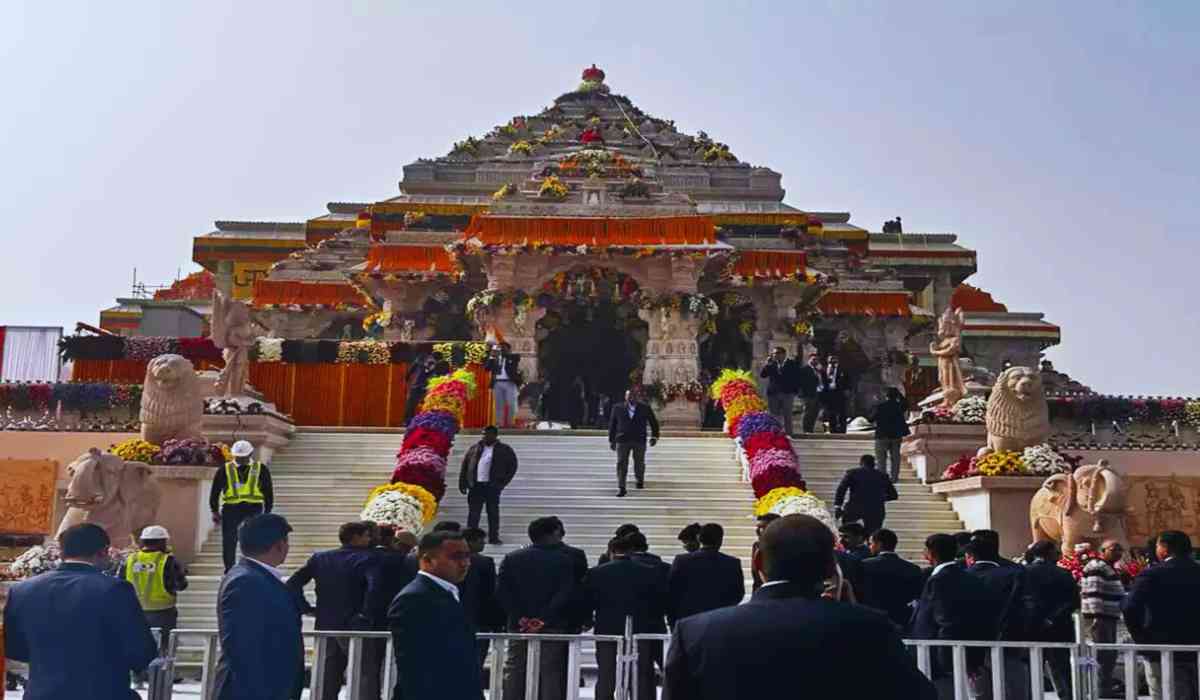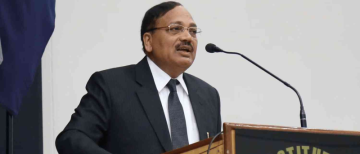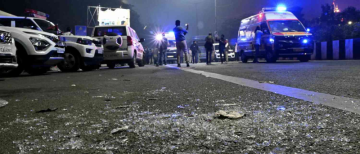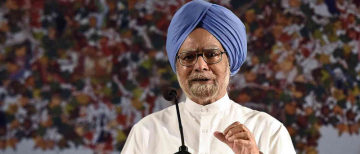The people of Ayodhya City were filled with joy that after 70 years, Lord Ram was finally moving from a small tent to a grand temple. Yet, the sadness in their eyes revealed the pain of losing their homes and livelihoods in the process.
Once a city with worn-out buildings and ancient temples, Ayodhya changed beyond recognition. Many costly redevelopment projects were launched for the city’s beautification and accommodation of the pilgrims coming to the temple.
Today, as you drive along the 13 km road connecting Faizabad to Saryughat, you will notice several demolished shops and houses obscured by large banners promoting PM Modi and the Ram Mandir development project.
On the 13-km stretch of Ram Path from Sahadatganj (old Faizabad) to Naya Ghat stretch now known as Ram Path, around 450 shops and 30 temples were demolished. Many of these shops had been run by the same families for generations.
Shop owners expressed two main concerns: first, the compensation they received was significantly lower than the market rate at the time, and second, they were anxious about repaying loans taken from family members to renovate their shops after the demolition. Although the compensation had been set at six times the circle rate, following the Supreme Court of India’s ruling on the Ram Janmabhoomi Title suit in 2019, the market rate had increased to more than ten times the circle rate.
While it was clear that the government aimed to develop the city for visitors, what about the people who had built their lives there? What about their survival amid all this destruction?
The Price of Progress: Demolition and Destruction
Ayodhya's path to transformation was not a smooth one for everyone. As the government moved ahead with plans to improve roads and infrastructure for the increasing number of pilgrims, many locals suffered silently. Shops, homes, and livelihoods were wiped out, leaving families in great distress. The government's development projects led to significant demolitions, uprooted businesses, and displaced people who had lived and worked in Ayodhya for generations.
Here’s how locals of Ayodhya express their sense of injustice done by the government”
“Bhookhe Bhajan na hoye Gopala, le teri kanthi, le teri mala...”
recites Tarawati with tears in her eyes when she witnesses bulldozers and trucks transforming her 10-acre ancestral land, which has been cultivated by her family for generations, into a parking lot, taking away their only source of livelihood.
Tarawati is one of many residents of Ayodhya who lost their land of agriculture, housing, and livelihood in the beautification process of the city.
Another lady angry with losing her house in the construction and development work, says, the Ram Mandir is made only for darshan, it can not accommodate the people (losing their houses). Visitors from outside will be happy to see the development. But where will the locals go?
In the widening of the Panch Parikrama Marg, small temples built by locals with faith and devotion had been destroyed.
Chaudhary Laxmiprasad Pandey, a local priest in Ayodhya, puts up a valid point: “The people have chosen the prime minister and chief minister to be their leaders. It is their duty to take care of their citizens.” He gives an example of how Lord Ram, the king of Ayodhya, would take on different identities to visit his town and inquire about the well-being and needs of his subjects. In the same city, the government is now disrupting the livelihoods of locals, leaving them at the mercy of time and poverty. Will Lord Ram be happy that on his welcome, his subjects are suffering miserably?
Ayodhya’s Forgotten Voices: Struggles of Local Vendors Amidst Promises of Progress
In Ayodhya, the struggles of local vendors amidst political promises highlight a stark contrast between development narratives and ground realities.
The 1800 crore budget for constructing the temple and other related development projects carried hidden costs. This cost was shouldered by many traders in the city. When the Supreme Court approved the temple's construction in 2019, it brought joy to the entire nation, including the traders. However, it also left them with feelings of disappointment and injustice.
Despite the construction of the Mandir, residents faced inadequate living conditions, forced relocations, and a lack of basic amenities like water and electricity in their new settlements, raising ethical concerns about government priorities and accountability.
Small vendors grapple with meager profits, societal mistrust, and relentless financial hardships, exacerbated by the pandemic. Their frustration reflects a broader economic disparity, as survival takes precedence over engaging with political processes. The disconnect between policy and reality is evident in broken promises, prolonged neglect, and the pressure vendors face in daily transactions, often forced to sell at a loss.
1800 Crore for Making the Temple? Was the Spending Justified?
The allocation of ₹1,800 crore for the construction of the Ram Lala temple also ignited a significant debate over its necessity, particularly in light of the country's urgent socio-economic issues. While cultural and religious initiatives are important, the potential benefits of this spending should not be ignored.
With better management, these funds could have been used for social programs, such as fair compensation for those displaced, job creation, or enhancing education for underprivileged children even after building the temple.
A telling example is the story of a farmer whose land was taken for the temple project. She shares, "Our entire livelihood depended on the farm. My children are illiterate and jobless. The government compensated us far less than the land's value. I only plead for a job for one of my children so we don’t die of hunger." This situation underscores the serious neglect of social duties and raises concerns about how resources are prioritized.
Ironically, many of those who suffered were strong supporters of the ruling party. Did their belief in their votes lead to this suffering? They revealed the answer themselves when the BJP lost their seats in the 2024 Lok Sabha elections from Ayodhya.
When Governance Disrupts Livelihoods: A Flawed Approach to Leadership
After the construction and opening of the Ram Mandir, Chief Minister Yogi Adityanath frequently visits the city to offer his prayers. However, these visits should also reflect good governance and a connection with the community. Ironically, they often lead to considerable difficulties for the very people the government aims to serve.
Vendors and daily wage earners face major disruptions as roadblocks and increased security measures hinder their ability to make a living. Shops remain closed for days, and transport workers are blocked from key routes, worsening their financial struggles. This situation reveals a troubling contradiction in governance—ceremonial priorities overshadow the basic rights of citizens.
The failure to consider alternative measures that balance security with public convenience shows a lack of foresight and empathy in leadership. This approach not only marginalizes economically vulnerable groups but also erodes trust in a government that seems indifferent to the immediate needs of its people. Leadership that claims to prioritize welfare cannot justify policies that force citizens to bear the burden of its presence.
As the Celebration Unfolds, Let's Reflect.
From January 11 to January 13, the anniversary of Rama Lalla's consecration is celebrated across the country. This significant date marks the moment Ram Lalla moved to his temple after nearly 70 years in a tent. The residents of Ayodhya are especially thrilled to celebrate forgetting the pain of their sufferings.
As aware citizens, isn't this our duty to speak up for those left in ruins while everyone focuses on the grand temple? Try to see things from their perspective. Isn’t this a significant story of injustice overshadowed by the narrative of development?
The current government views the construction of the temple as a significant triumph, yet the challenges faced by local residents highlight a failure in their welfare efforts. The long-term effects on the lives of Ayodhya's people warrant careful consideration and dialogue.
As the celebration begins today, we must consider: Did the people who suffered deserve the injustice? Did Lord Rama ask to make the poor suffer?
With inputs from agencies
Image Source: Multiple agencies
The views expressed are personal to the author and do not reflect the platform's opinion of the same.
© Copyright 2024. All Rights Reserved Powered by Vygr Media.
Author's Profile
Ayushi is passionate about creating content that not only interests the reader but actually helps them add to their knowledge. Holding a degree in science, Ayushi is exploring her creative writing as she transforms ideas into compelling narratives that resonate with readers.

























